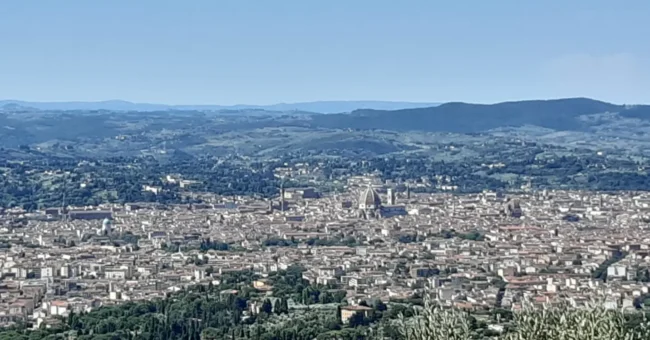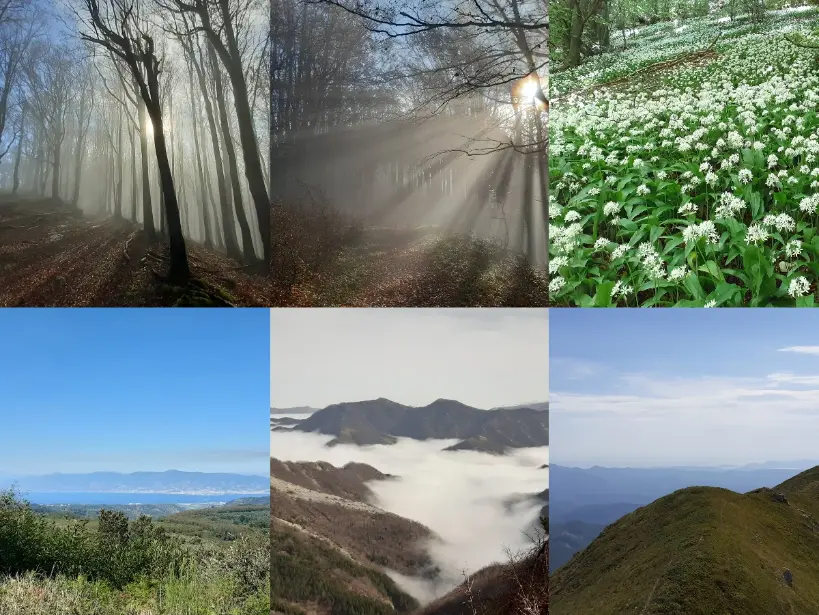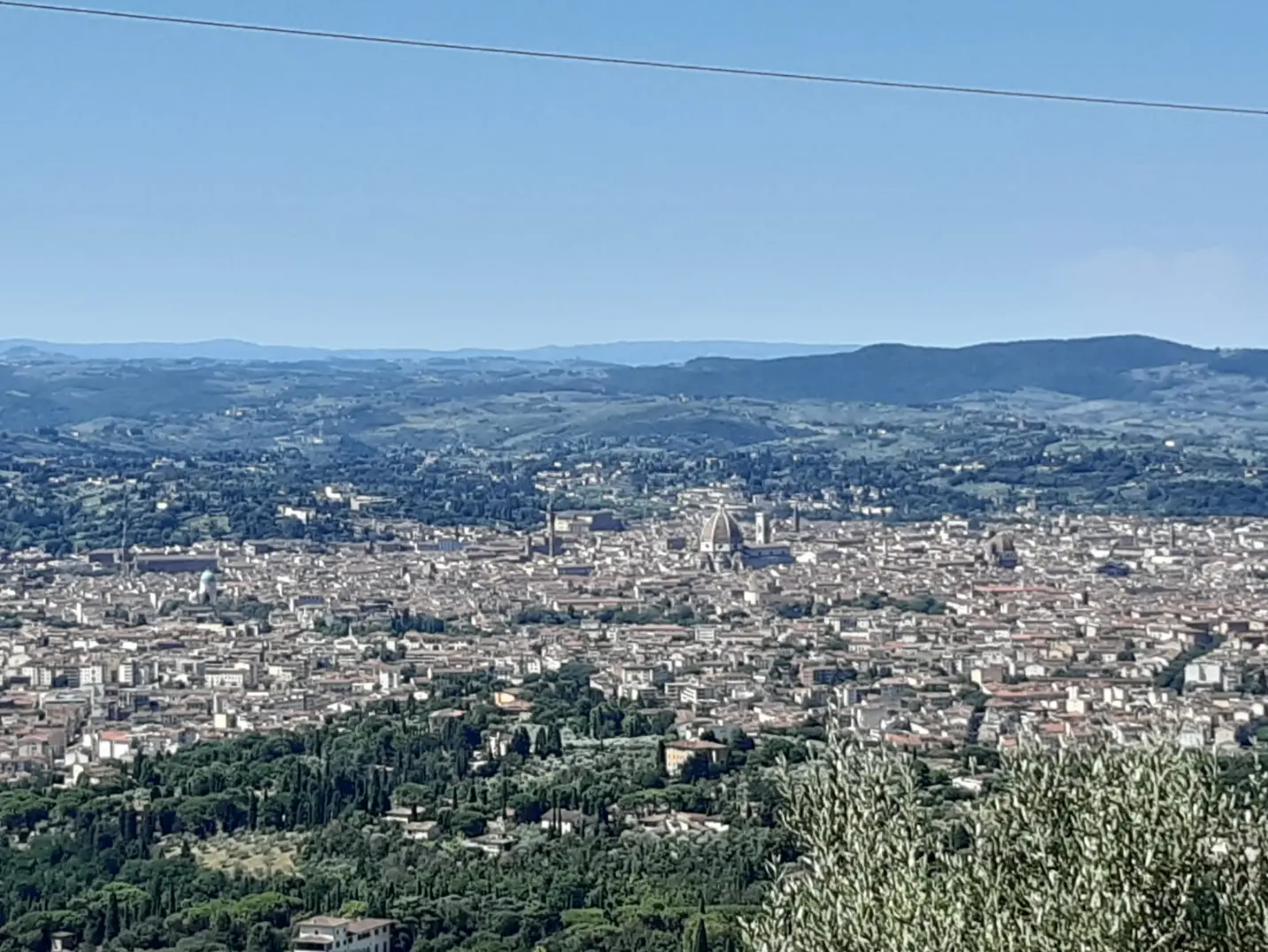
Via degli Dei, Italy. Photo credit: Fabio Viroli
The other, more intimate side of Italy
In this article, I want to tell you about a different and lesser-known part of Italy. It’s a deeply genuine and yet still beautiful side of my country: the Apennines.
Less famous and touristy places in Italy
Everyone in the world knows Italy’s biggest cities – but also its beaches, the Alps, and many smaller, yet still famous towns across the peninsula. And many people, rightly so, go there every year.
But when you visit those places, you might be overwhelmed by a frantic tour guide, standing in line with a huge group that’s spending just one week across all of Europe, so much that they might not even remember if they’re in Paris or Rome that day.
In my opinion, one week is just enough for Rome alone.
The Apennines trek
Everyone knows that Italy looks like a boot; just take a look at the map. If you look more closely, that boot has a sort of crown at the top: the Alps. But it also has a spine running down its length – the Apennines.
This mountain range begins where the Alps end and stretches all the way south to Calabria, covering about 1,200 kilometers.
The highest peaks, like Gran Sasso, reach up to 2,900 meters, but most of the range is lower and covered with beautiful forests. Many of these areas are now national parks, preserving a wild, untouched nature. Some animals that are extinct in other parts of Europe, like wolves and bears, still live here.
In some places, you can see both the Tyrrhenian Sea (to the west) and the Adriatic Sea (to the east). And at the southern tip, in Aspromonte, there’s an incredible view of the sea on three sides – and even Sicily, with the great volcano Etna so close.
History woven into the mountains
Over the centuries, the routes crossing the Apennines were essential for both armies and pilgrims. Many important historical sites remain — from the Roman Empire (some Roman roads still exist today) to those linked to the Second World War.
During WWII, the Nazi army used the harshness of the terrain to its advantage, building defensive lines to stop the Allied advance. The most famous were the Gustav Line in the south and the Gothic Line in the north. Near the Gothic Line, partisan resistance was particularly strong, especially during the long winter of 1944, when the Allies decided to pause the Italian campaign. That area saw many Nazi-Fascist massacres, one of which was depicted in Spike Lee’s film Miracle at St. Anna.
Starting especially in the Middle Ages, pilgrims from all over Europe began travelling to Rome or Jerusalem, crossing the Apennine passes, which often marked the borders between the many small states that made up Italy at the time.
Some photos from Sentiero Italia and Via degli Dei – photo credit: Fabio viroli
Walking the ancient trails
Today, there are highways and paved roads through the Apennines, but it’s still possible to walk along many of the ancient routes once used by armies and pilgrims. There are countless trails, both religious and historical, suited to every kind of traveller. For trekking lovers, there are convenient solutions like dedicated apps and accommodations. And for those who prefer short hikes, scenic views, or simply enjoying good food, the Apennines are full of rewarding surprises.
You’ll find fewer tourists and less famous towns, but the cultural richness is still there – and in my opinion, so is the best food in Italy.
Sentiero Italia
The Apennines cover such a vast area that it’s hard to list specific towns or paths. I’ve been lucky enough to explore the north, centre, and south. One of the most incredible trails is the Sentiero Italia (Italian Trail) – one of the longest hiking routes in the world. It crosses the Alps and the entire Apennine ridge, with sections in Sicily and Sardinia too. In Italian, “SI” means “yes,” and it also stands for Sentiero Italia. It’s about 7,000 km long, and it’s my dream to hike it all one day, though for now, I often walk small parts of it.
My journey on the Via degli Dei
One trail I have completed is the Via degli Dei (Street of the Gods or Path of the Gods). It’s a great way to experience both the Apennines and some iconic Italian cities. The trail is named after several places along the route with mythological names – the most beautiful, in my opinion, is Madonna dei Fornelli (“Our Lady of the Stoves”). I recommend starting in Bologna and finishing in Florence: that way, you can see the iconic dome of Brunelleschi’s Cathedral in Florence appearing from the mountains.
Florence seen from the final stretch of the Via degli Dei — the iconic dome of Brunelleschi rising above the city, marking the end of a journey through the Apennines. Photo credit: Fabio Viroli
Strange adventures in the Apennines
Travel often brings surprises, even close to home. On the first night of the Via degli Dei, I couldn’t sleep. I thought it was just the exhaustion, but during the night, I heard strange animal sounds. The next day, I discovered there was a nearby wildlife recovery centre. Those sounds? Lions and tigers!
To prepare for the trail, I had spent the previous weekend camping in the Casentinesi Forests National Park, between Tuscany and Emilia-Romagna. During a hike, I got lost near the famous Camaldoli monastery. Luckily, I stumbled upon a girl sitting on a rock with a map. She was from a town just ten minutes from mine, yet here we were, three hours away from home, camping at the same site. Maybe she was the most beautiful girlfriend I ever had, even if our story didn’t last long. I called her the lady of the woods.
Another time, I was hiking near Monte Cucco on the border between Umbria and Marche. Suddenly, I found myself in a sea of wild garlic flowers, a stunning mix of smells and colours, even though I don’t usually like garlic. But that day, it was magical.
Discover more
If you’re curious about the Apennines, here are some helpful resources:
- Sentiero Italia
- Via degli Dei (https://www.viadeglidei.it)
- Italian Parks Network
You can also visit my blog, where I write about my adventures around the world:👉 www.strangethingstraveling.com










Awesome! Its genuinely remarkable post, I have got much clear idea regarding from this post
Thank you Lisa! I’m very happy with what you wrote
I very delighted to find this internet site on bing, just what I was searching for as well saved to fav
Thanks!